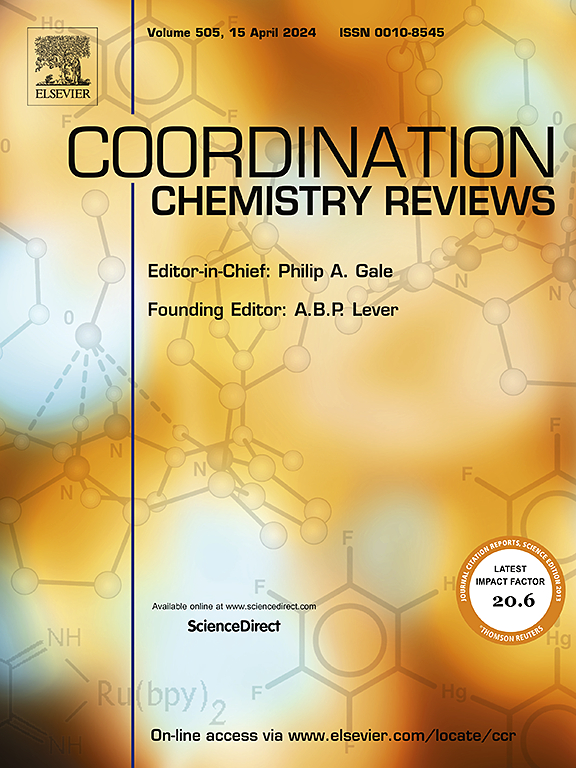纳米颗粒集成水凝胶作为多功能比色传感器
IF 20.3
1区 化学
Q1 CHEMISTRY, INORGANIC & NUCLEAR
引用次数: 0
摘要
纳米粒子由于其易于表面功能化和结合了光学和催化性质而被广泛用作比色传感器的探针。然而,它们固有的聚集倾向损害了独特的等离子体性质,并降低了与纳米尺寸相关的催化活性,潜在地影响了长期性能。为了解决这些限制,最近的研究集中在将纳米颗粒整合到水凝胶中,从而限制纳米颗粒的扩散,以克服比色传感应用中的挑战。特别是,纳米颗粒集成水凝胶可以保持纳米颗粒的胶体稳定性,确保在现场场景中自由纳米颗粒无法实现的实际适用性。本文全面回顾了纳米颗粒集成水凝胶在比色传感应用方面的最新进展,特别强调了它们在检测生物和环境目标方面的能力。这些水凝胶独特的物理化学性质为部署各种聚合物和金属纳米颗粒提供了理想的平台,这些纳米颗粒对环境变化高度敏感,可以直观地指示特定目标的存在。由于其高含水量、浓度效应和独特的膨胀特性,水凝胶也增强了传感器的性能,从而增强了传感器对目标分子的响应。最后,本文对这一动态领域的未来研究进行了展望。本文章由计算机程序翻译,如有差异,请以英文原文为准。

Nanoparticle-integrated hydrogels as versatile colorimetric sensors
Nanoparticles have been extensively employed as probes in colorimetric sensors due to their ease of surface functionalization and combined optical and catalytic properties. However, their intrinsic tendency to aggregate impairs the unique plasmonic properties and diminishes catalytic activity associated with their nanoscale size, potentially compromising long-term performance. To address these limitations, recent studies have focused on integrating nanoparticles into hydrogels, thereby limiting nanoparticle diffusion to overcome challenges in colorimetric sensing applications. In particular, nanoparticle-integrated hydrogels can preserve the colloidal stability of nanoparticles, ensuring practical applicability that is unattainable with free nanoparticles for on-site scenarios. This article comprehensively reviews recent advances in nanoparticle-integrated hydrogels for colorimetric sensing applications, with particular emphasis on their abilities to detect biological and environmental targets. The unique physicochemical properties of these hydrogels provide ideal platforms for deploying various polymeric and metallic nanoparticles that are highly sensitive to environmental changes and can visually indicate the presence of specific targets. Hydrogels also enhance sensor performance owing to their high-water contents, concentration effect, and distinctive swelling properties, which amplify sensor responses to target molecules. In the end, this review article outlines promising avenues for future research in this dynamic field.
求助全文
通过发布文献求助,成功后即可免费获取论文全文。
去求助
来源期刊

Coordination Chemistry Reviews
化学-无机化学与核化学
CiteScore
34.30
自引率
5.30%
发文量
457
审稿时长
54 days
期刊介绍:
Coordination Chemistry Reviews offers rapid publication of review articles on current and significant topics in coordination chemistry, encompassing organometallic, supramolecular, theoretical, and bioinorganic chemistry. It also covers catalysis, materials chemistry, and metal-organic frameworks from a coordination chemistry perspective. Reviews summarize recent developments or discuss specific techniques, welcoming contributions from both established and emerging researchers.
The journal releases special issues on timely subjects, including those featuring contributions from specific regions or conferences. Occasional full-length book articles are also featured. Additionally, special volumes cover annual reviews of main group chemistry, transition metal group chemistry, and organometallic chemistry. These comprehensive reviews are vital resources for those engaged in coordination chemistry, further establishing Coordination Chemistry Reviews as a hub for insightful surveys in inorganic and physical inorganic chemistry.
 求助内容:
求助内容: 应助结果提醒方式:
应助结果提醒方式:


